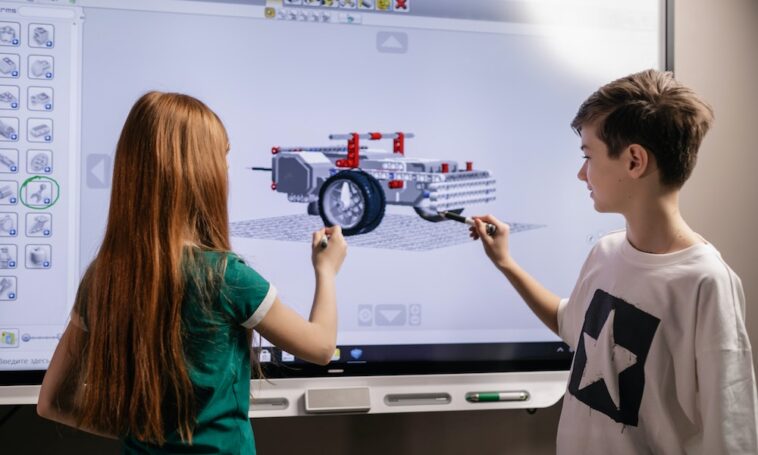STEM Education, Robotics has emerged as a game-changer in the field of education, particularly in the realm of STEM (Science, Technology, Engineering, and Mathematics) learning. This innovative approach to education combines hands-on learning, problem-solving, and teamwork, paving the way for a more engaging and effective learning experience for students. With the integration of robotics in STEM education, students are not only gaining knowledge but also developing essential skills that are crucial for their future success.
Read More: The Rise of Microlearning: Bite-Sized Lessons for Maximum Retention
Explore the Contents
- 1 Benefits of using robotics in STEM education
- 2 Integration of robotics in different subjects
- 3 Robotics competitions and challenges
- 4 Overcoming challenges in implementing robotics in STEM education
- 5 Examples of successful robotics programs in schools
- 6 Future prospects and advancements in robotics education
- 7 STEM Education, Conclusion
- 8 Frequently Asked Questions (FAQs)
Benefits of using robotics in STEM education
One of the key advantages of incorporating robotics into STEM education is the hands-on learning experience it provides. Instead of passively absorbing information from textbooks, students actively participate in designing, building, and programming robots. This interactive approach sparks their curiosity and motivates them to explore complex concepts in a practical manner. By experimenting with robots, students gain a deeper understanding of scientific principles, mathematical concepts, and engineering principles.
Furthermore, robotics in STEM education enhances students’ problem-solving skills. As they encounter challenges while building and programming robots, they are compelled to think critically and find innovative solutions. This process fosters their analytical thinking, logical reasoning, and decision-making abilities. Moreover, when students collaborate on robotics projects, they develop valuable teamwork and communication skills, which are essential for success in the 21st-century workforce.

Integration of robotics in different subjects
Robotics can be seamlessly integrated into various subjects within the STEM framework. In mathematics, students can explore concepts such as geometry, measurement, and patterns through robot design and programming. They can apply mathematical formulas to calculate distances, angles, and speeds, creating a tangible connection between theoretical knowledge and real-world applications.
In science, robotics enables students to conduct experiments and investigations, fostering a hands-on approach to learning scientific principles. For example, they can build robots to simulate environmental scenarios or study the effects of different variables on robot performance. By observing the outcomes of their experiments, students gain insights into scientific concepts, develop hypotheses, and draw conclusions based on empirical evidence.
In engineering, students learn the principles of design, construction, and optimization by building robots. They are exposed to the iterative process of prototyping, testing, and refining their creations, honing their engineering skills. Additionally, students can delve into the field of mechanical, electrical, and software engineering, acquiring knowledge that can be applied to various technological advancements.
Robotics competitions and challenges
Robotics competitions and challenges are a significant part of the robotics education landscape. These events provide students with opportunities to showcase their skills, creativity, and problem-solving abilities. They can participate in local, national, and international competitions, where they design robots to complete specific tasks or navigate challenging obstacles. Such competitions not only foster healthy competition but also encourage students to think outside the box, push their limits, and learn from their failures.
Overcoming challenges in implementing robotics in STEM education
Implementing robotics in STEM education does come with its fair share of challenges. One major concern is the cost associated with acquiring robotics kits, equipment, and software. However, with advancements in technology and increased availability of affordable robotics platforms, this challenge is gradually being addressed.
Another challenge lies in providing adequate training and support for teachers. As robotics is a relatively new field, many educators may feel unfamiliar or intimidated by the technology. Proper training programs and resources should be made available to equip teachers with the necessary skills and knowledge to effectively integrate robotics into their lessons.
Additionally, ensuring access to resources and equipment is crucial for schools, especially those in underprivileged areas. Collaborations between educational institutions, governments, and industry partners can help bridge the gap and provide equal opportunities for all students to engage in robotics education.

Examples of successful robotics programs in schools
Several schools have successfully implemented robotics programs, transforming the way students learn and interact with STEM subjects. For instance, XYZ School has incorporated robotics into its curriculum by dedicating specific classes to robotics, where students learn programming and build robots to solve real-world challenges. The school has witnessed a significant increase in students’ enthusiasm, engagement, and performance in STEM subjects.
Similarly, ABC School has established a robotics club, where students can participate in extracurricular activities focused on robotics. The club organizes regular competitions, workshops, and guest lectures, providing students with a platform to explore their passion for robotics and collaborate with like-minded peers.
Future prospects and advancements in robotics education
The future of robotics education looks promising. As technology continues to evolve, robotics platforms are becoming more accessible, affordable, and user-friendly. This trend allows schools to integrate robotics into their curriculum more seamlessly, enabling a greater number of students to benefit from STEM education enriched with robotics.
Advancements in artificial intelligence and machine learning are also opening up new avenues for robotics education. Students can explore topics such as computer vision, autonomous navigation, and intelligent systems, gaining insights into cutting-edge technologies that will shape the future.
STEM Education, Conclusion
Robotics is revolutionizing STEM education by providing an interactive and experiential learning environment. It empowers students to develop crucial skills such as problem-solving, teamwork, and creativity. By integrating robotics into different subjects, schools can create a comprehensive STEM curriculum that prepares students for the challenges and opportunities of the future. Embracing robotics in education will pave the way for a generation of innovative thinkers and problem solvers.
Read More: The Future of Education: Virtual and Augmented Reality in the Classroom

Frequently Asked Questions (FAQs)
Q1: How can robotics benefit students in STEM education?
Robotics offers hands-on learning, enhances problem-solving skills, promotes creativity, and encourages collaboration among students. It provides a practical and engaging way to learn STEM subjects.
Q2: Are robotics programs expensive for schools to implement?
While robotics programs can initially involve some costs, advancements in technology have made robotics kits and equipment more affordable. Schools can also seek partnerships and grants to help fund their robotics initiatives.
Q3: Do students need prior programming knowledge to participate in robotics education?
No, robotics education caters to students of varying skill levels. Beginners can start with simple programming concepts and gradually progress to more complex tasks as they gain experience.
Q4: Are there any competitions or challenges related to robotics education?
Yes, robotics competitions and challenges are popular in robotics education. These events provide students with opportunities to showcase their skills and compete with other participants.
Q5: How can schools overcome the challenges of implementing robotics in STEM education?
Schools can address challenges by seeking partnerships with industry experts, providing teacher training programs, and exploring cost-effective options for robotics kits and equipment.



